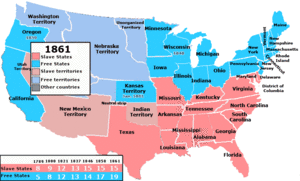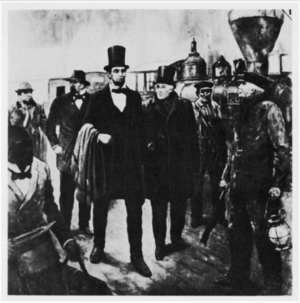Presidential transition of Abraham Lincoln facts for kids
The presidential transition of Abraham Lincoln was the time between when Abraham Lincoln won the 1860 United States presidential election and when he became president on March 4, 1861. During this period, Lincoln was the president-elect of the United States.
This transition happened during a very difficult time for the country. Many Southern states were threatening to leave the United States. This period is often called the "secession crisis." It was one of the hardest times any president-elect has ever faced.
During his transition, Lincoln chose people for his team, called the Cabinet. He also tried to stop Southern states from leaving the Union. He even traveled secretly to Washington, D.C., to avoid a possible assassination attempt. This plot was known as the Baltimore Plot.
Contents
Lincoln Wins the Election
Abraham Lincoln was elected the 16th president on November 6, 1860. The very next day, newspapers reported his victory. Lincoln won a strong electoral college victory. This was because he won in all the Northern and Western states. He did not get any votes in ten of the fifteen Southern states where slavery was allowed. He won only two out of 996 counties in all the Southern states.
The Secession Crisis Begins
Many people in the South were very angry about Lincoln's election. They feared he would end slavery. Because of this, some Southern states planned to leave the Union. This plan was put into action before Lincoln even took office in March 1861. All the states where slavery was legal started thinking about leaving. They worried that Lincoln's presidency would threaten slavery.
Lincoln was not set to become president until March 1861. So, James Buchanan, the current president, was still in charge. President Buchanan was from Pennsylvania and was often friendly to the South. He said that states could not legally leave the Union. But he also said the government could not stop them. Lincoln had no official power to act while the crisis grew.
Many people gave Lincoln advice. Some wanted him to promise the South that slavery would be safe. Lincoln knew that such promises would upset his own Republican supporters. But taking a strong stand against states leaving would make Southerners even angrier. So, Lincoln decided to stay mostly quiet. He hoped that if he did nothing threatening, Southern people who wanted to stay in the Union would win out.
In December 1860, both the House and Senate formed special groups. These groups were meant to deal with the growing crisis. Lincoln told some lawmakers that he was open to talks on some issues. These included runaway slaves and slavery in Washington, D.C.. However, he was very clear about one thing. He would never allow slavery to spread into any new states or territories.
One special group was the Committee of Thirty-three. It was formed on December 4, 1860. This group had one member from each of the 33 states. They suggested enforcing the Fugitive Slave Act. This law made it easier to return runaway slaves. They also suggested allowing New Mexico to become a slave state. And they wanted to get rid of laws in the North that protected runaway slaves. Lincoln said no to all these ideas.
Around mid-December, Senator John J. Crittenden of Kentucky offered a plan. It was called the Crittenden Compromise. This plan included six changes to the Constitution. It would protect slavery in federal lands south of a certain line (the 36°30′ parallel). It would ban slavery north of that line. New states could decide for themselves if they wanted slavery. Congress would not be allowed to end slavery in any state. It also could not stop the trade of slaves within the country.
Lincoln and his Republican Party refused to support this plan. It went against their main idea of keeping slavery out of new territories. Lincoln privately asked Republican Senators to vote against it. The compromise failed to pass Congress. Lincoln said he would "suffer death" before agreeing to any deal that allowed slavery to expand.
Lincoln thought the Southern threats were mostly talk. He believed the crisis would calm down, as it had before. But many Southerners were sure that Lincoln's presidency would eventually end slavery. On December 20, 1860, South Carolina voted to leave the Union. Six other Southern states left over the next 40 days. In February, these states formed the Confederate States of America (CSA). On February 9, they chose Jefferson Davis as their temporary president.
Even with the CSA formed, some states where slavery was legal stayed in the Union. These included Arkansas, North Carolina, Tennessee, Virginia, Delaware, Maryland, Kentucky, and Missouri. President Buchanan and President-elect Lincoln both said the Confederacy was illegal.
In February 1861, two more efforts were made to save the Union. One was a "Peace Conference" held in Washington, D.C. Delegates from 21 states attended. They suggested a plan similar to the Crittenden Compromise. But Congress rejected it. The second effort was a constitutional amendment. It would protect slavery in states where it already existed. This was known as the Corwin Amendment. Congress approved it, and Lincoln quietly supported it. But it was only approved by a few states and soon forgotten.
Building Lincoln's Cabinet
Lincoln started choosing his Cabinet on election night. The Cabinet is a group of top advisors who help the president run the country. Lincoln wanted to pick people who would unite the Republican Party. He made sure to include both former members of the Whig Party and former members of the Democratic Party. His Cabinet ended up including all his main rivals for the Republican nomination. Lincoln was not afraid to have strong-minded people on his team. Even if they seemed more experienced than him.
The first Cabinet job Lincoln filled was Secretary of State. This is usually the most important Cabinet position. It was common for the president-elect to offer it to the most popular person in their party. For the Republicans, that person was William H. Seward. On December 8, 1860, Lincoln wrote to Seward, offering him the job. Seward had been sad he didn't win the presidential nomination. But he agreed to be Lincoln's Secretary of State.
Lincoln chose Salmon P. Chase of Ohio to be Secretary of the Treasury. Chase was Seward's main political rival. He led the more extreme group of Republicans who wanted to end slavery quickly. Seward and others did not want Chase chosen. They worried about his strong anti-slavery views. Lincoln first offered the job to Simon Cameron of Pennsylvania. But after some problems, Lincoln took back his offer to Cameron in January.
Even though Lincoln took back the Treasury offer, he did choose Simon Cameron to be his Secretary of War. Cameron was a controversial choice. He was powerful, but some people thought he was corrupt. His appointment was opposed by some in his own state of Pennsylvania. But in the end, it was important for Pennsylvania to have someone in the Cabinet. So Cameron became Secretary of War. Some historians believe this choice showed Lincoln did not expect a civil war.
Montgomery Blair of Maryland was chosen to be Postmaster General. He was popular among anti-slavery Democrats. He was one of only two people from a border state to serve in Lincoln's Cabinet.
Lincoln asked Hannibal Hamlin, the Vice President-elect, to find someone from New England for the Cabinet. Hamlin suggested Gideon Welles of Connecticut. Welles was a former Democrat who had worked in the Navy Department. Other important Republicans agreed. Welles became Secretary of the Navy.
For Secretary of the Interior, Lincoln chose Caleb Blood Smith of Indiana. Smith was a former Whig, like Lincoln. Some people criticized him for his business dealings. They also questioned if he was smart enough for a high government job. But Smith had worked hard for Lincoln's campaign. And they were friends. So, he got the job.
Journey to Washington, D.C.
On February 11, 1861, Lincoln got on a special train. Over the next two weeks, this train would take him to the nation's capital. Lincoln gave a very emotional farewell speech when he left his hometown of Springfield, Illinois. He would never return to Springfield alive. Lincoln spoke several times each day during the train trip. He talked to crowds and lawmakers across the North. His speeches were mostly made up on the spot. But his message was always the same: he had no bad intentions toward the South. He also said that states leaving the Union was not acceptable. And he planned to enforce the laws and protect property.
During the trip, there were many rumors of plots to kill Lincoln. A railroad president hired a detective named Allan Pinkerton. Pinkerton found information that suggested an attempt on Lincoln's life would happen in Baltimore. Because of this threat, Lincoln's travel schedule was changed. The train tracks were cleared, and telegraph wires were even cut for safety. Lincoln and his group passed through Baltimore very early in the morning on February 23. They avoided the plot and arrived safely in Washington, D.C., a few hours later. The capital was under heavy military guard.
Because Lincoln changed his schedule and wore simple clothes to stay hidden, some critics made fun of him. They said he snuck into Washington in disguise. Soon after arriving, Lincoln met with President Buchanan and leaders from Congress. He also worked to finish choosing his Cabinet. He met with Republican Senators to get their ideas.



